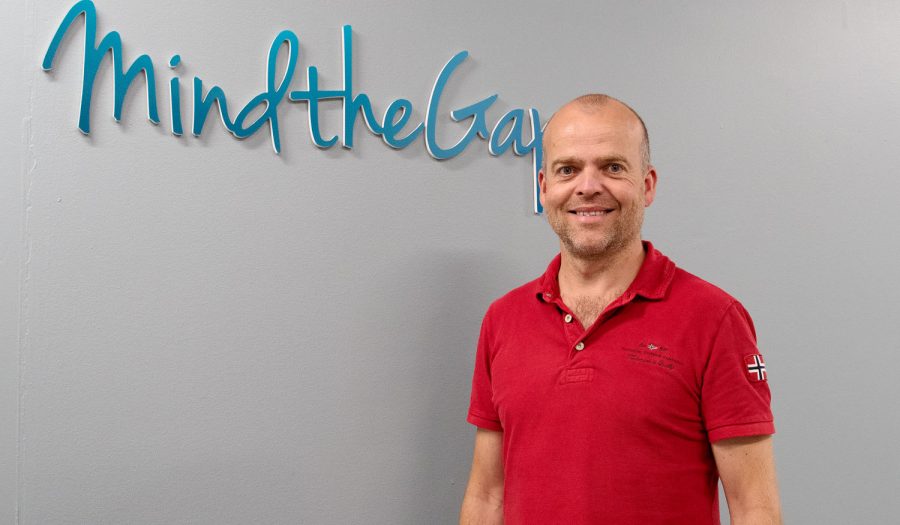
Testing tomorrows solutions in HelseCampus Stavanger
Technology and collaboration are flourishing in HelseCampus. The Empathic Building solution is installed, and many different indoor tracking sensors are being tested. - This will be as common as WiFi in the future, says one of the suppliers.
Text and photo: Jofrid Åsland, communications manager NSCC
Please note that TietoEVRY's Empathic Building solution was acquired by Haltian after the publication of this article. Haltian now owns this solution, and Gunnar Hansen is now responsible for the hospital sector in the company Haltian.
Norwegian Smart Care Cluster and the Lab that is a part of the cluster is running this project. They run it together with the company TietoEVERY and other companies that provides sensor technology. The solution that is installed is called Empathic Building and contains many different tracing sensors.
– Our big goal is to change the way of work in a hospital, says Gunnar Hansen in Tieto EVERY.
He is responsible for Empathic Buildings solutions for hospitals.
Cooperation between sectors
The solution is now running in the facilities of HelseCampus Stavanger in Norway. HelseCampus is a project where several institutions cooperate, and one of their goals is to stimulate cooperation between different sectors.
– We are very happy for the cooperation with TietoEVERY. Their platform has a lot of relevant functions that can be useful in hospitals, municipalities and the private marked. It will be exiting to follow the further development and activities in the years to come, says Karoline Blikra Mokleiv. She works for the Norwegian Smart Care Lab coordinating how the companies use the facilities of HelseCampus Stavanger.
– Solutions for welfare technology can be challenging to present because it is not a physical product (you can touch). Now that Empathic Building is installed other members from our cluster will also have the opportunity to visualize their solutions in this project. This is also an opportunity for Municipalities who plan to purchase welfare technology. They can ex test different products in use, says Blikra Mokleiv.

Indoor positioning - the new WIFI
Quuppa is one the companies testing their solution for indoor tracking together with TietoEVRY in HelseCampus Stavanger.
– The key drivers now days are social distancing and disease management. Before that we had tracking of equipment, like finding the wheelchair, finding the bed and so on. In a hospital they have a lot of extra equipment just simply because they cannot find them, says Christoffer Segercrantz from Quuppa.
He describes the solution as an indoor GPS that will make health care much more efficient.
– When we got the invitation to join this project, we couldn’t say no. This was a marvellous opportunity to join up with a total solution for the health care marked, says Segercrantz.
Quuppa is delivering real time indoor positioning (RTLS), with a system of locators with a type of antennas and tags. Everything you want to track you put a tag on. The system pick up what you tag, and can transform the information to for example a screen like it is done in the project Empathic Building.
– It is really up to the end user to decide what they want to do with the positioning, and time stamps available through the system. I think this will be as common as WIFI in the future. There are so many possibilities once you have the opportunity to locate things in real time indoors. You will save money, you will save time, you will be less stressed, you have more security around your self – we make life much easier, says Segercrantz.
How does it work?
Hear Christoffer Segercrantz explain how Quuppas solution for indoor tracking works
Saving time and money
There are several other companies that deliver solutions with different types of sensors and tracking. Sonitor is one of the companies. Their solution for tracking is used all over the world.
Studies from health care in USA using the system over a five-month period showed RTLS successfully reduced the average cycle time per patient by 25 %, increasing patient satisfaction. They converted over 4.500 minutes each week, which allowed them to add more patient visits resulting in additional surgical cases, having a direct impact on the budget.
Nursing hours were also dramatically reduced allowing nursing staff to be reallocated to other lines of service, maximizing utilization and optimizing resource capacity needs.
This information was published in Becker's Health IT and CIO Report, January 18, 2018.
MAIN PICTURE - Gunnar Hansen is responsible for Empathic Buildings solutions for hospitals.




